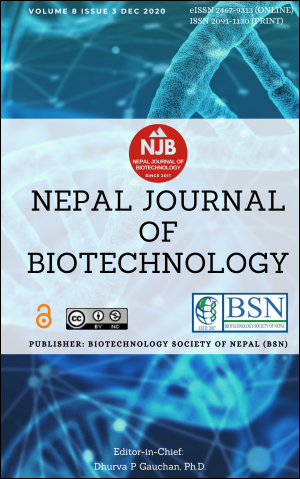Antibiogram of Escherichia coli and Staphylococcus aureus Isolated from Milk Sold in Kathmandu District
DOI:
https://doi.org/10.3126/njb.v8i3.30080Keywords:
Antibiotic resistance, Milk borne infection, Multidrug resistance, E. coli, S. aureus, MRSA, Total Bacterial CountAbstract
The emergence of antibiotic resistance in microorganisms and the presence of such isolates in milk pose a great risk to public health. Therefore, this study aims to determine the antibiotic susceptibility pattern of Escherichia coli and Staphylococcus aureus isolated from milk and assess the microbial quality of milk. For this, a total of 70 milk samples were collected and the total bacterial count (TBC) was determined. E. coli and S. aureus were isolated using their respective selective media while antibiotic susceptibility testing was carried out by Kirby Bauer Disc Diffusion method. The TBC showed that the raw milk samples contained two-fold higher microbial load while the pasteurized milk samples contained four-fold higher microbial loads than the standard guidelines. A total of 62 isolates were identified from culture-positive milk samples of which 32 were E. coli and 30 were S. aureus. A significant correlation was observed between microbial load and the organism isolated (r = 0.339, p<0.01). All S. aureus isolates were susceptible to Chloramphenicol while 40% were resistant to Cefoxitin, indicating the presence of Methicillin resistant S. aureus (MRSA). Also, 12 multidrug resistant (MDR) S. aureus were identified. While for E. coli, all were susceptible to Chloramphenicol but resistant to Ampicillin. Also, 9 MDR E. coli were detected. Higher resistance was observed among isolates from the raw milk samples than the pasteurized milk. It can be concluded that the milk produced by small-scale farms and dairy industries of Kathmandu district are of poor quality. Hence, routine microbial quality assessment and antimicrobial resistance monitoring should be followed to safeguard public health.
Downloads
Downloads
Published
How to Cite
Issue
Section
License
Copyright Notice:
The manuscript submitted to NJB must be an original contribution, not previously published and should not be under consideration for publication elsewhere. When the manuscript is accepted for publication, the authors agree to automatically transfer the copyright of the article to the publisher. It should grant permission to any third party, in advance and in perpetuity, the right to use, reproduce or disseminate your article, according to the NJB copyright and license agreement.
Authors transfer copyright to the publisher as part of a journal publishing agreement but have the rights to: Share their article for Personal Use, Internal Institutional Use and Scholarly Sharing purposes, with the NJB applies the Creative Commons Attribution-NonCommercial CC BY-NC license to all the works we publish after Jun 2020 (Before it was CC BY-NC-ND). Under this license, authors agree to make articles legally available for reuse, without permission or fees, for virtually any non-commercial purpose. Anyone may remix, adapt, and build upon your work non-commercially, and although their new works must also acknowledge you and be non-commercial, they don’t have to license their derivative works on the same terms. More details on CC BY-NC refer to its Licence Deed and Legal Code.






